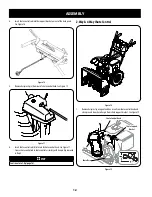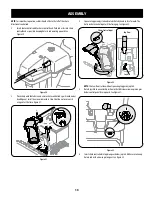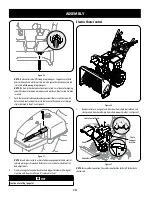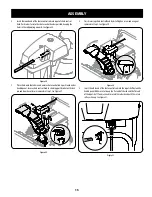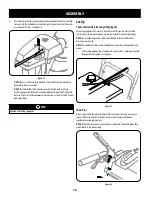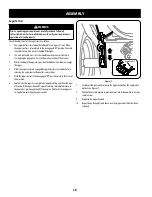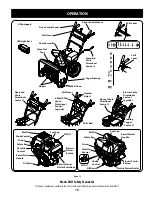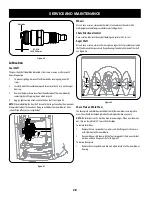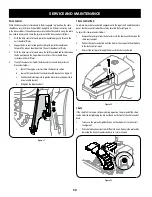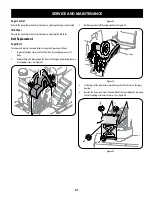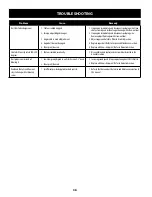
24
OPERATION
Electric Starter
WARNING
The electric starter is equipped with a grounded three-wire power plug,
and is designed to operate on 120 volt AC household current. It must be
used with a properly grounded three-prong receptacle at all times to avoid
the possibility of electric shock. Follow all instructions carefully prior to
operating the electric starter. DO NOT use electric starter in the rain.
Determine that your home’s wiring is a three-wire grounded system. Ask a licensed
electrician if you are not certain.
If you have a grounded three-prong receptacle, proceed as follows. If you do not
have the proper house wiring, DO NOT use the electric starter under any conditions.
1.
Plug an extension cord into the outlet located on the engine’s surface. Plug
the other end of extension cord into a three-prong 120-volt, grounded, AC
outlet in a well-ventilated area.
CAUTION
The extension cord can be any length, but
must
be rated for 15 amps at
125 volts, grounded and rated for outdoor use.
2.
Move throttle control to FAST (rabbit)
position.
3.
Move choke to the CHOKE
position (cold engine start). If engine is
warm, place choke in RUN position.
4.
Push primer three (3) times, making sure to cover vent hole in primer bulb
when pushing. If engine is warm, push primer only once. Always cover vent
hole when pushing. Cool weather may require priming to be repeated.
5.
Push starter button to start engine. Once the engine starts, immediately
release starter button. Electric starter is equipped with thermal overload
protection; system will temporarily shut-down to allow starter to cool if
electric starter becomes overloaded.
6.
As the engine warms, slowly rotate the choke control to RUN position. If the
engine falters, restart engine and run with choke at half-choke position for a
short period of time, and then slowly rotate the choke into RUN position.
7.
After engine is running, disconnect extension cord from electric starter.
When disconnecting, always unplug the end at the wall outlet before
unplugging the opposite end from the engine.
Recoil Starter
CAUTION
Do not pull the starter handle while the engine running.
1.
Move throttle control to FAST (rabbit)
position.
2.
Move choke to the CHOKE
position (cold engine start). If engine is
warm, place choke in RUN position.
3.
Push primer three (3) times, making sure to cover vent hole when pushing.
If engine is warm, push primer only once. Always cover vent hole when
pushing. Cool weather may require priming to be repeated.
4.
Pull gently on the starter handle until it begins to resist, then pull quickly
and forcefully to overcome the compression. Do not release the handle and
allow it to snap back. Return rope SLOWLY to original position. If required,
repeat this step.
WARNING
Keep a firm grip on the starter cord handle to prevent rapid retraction of
starter cord (kickback). Rapid retraction can pull hand and arm toward
engine faster than you can let go, and result in broken bones, fractures,
bruises or sprains.
5.
As the engine warms, slowly rotate the choke control to RUN position. If the
engine falters, restart engine and run with choke at half-choke position for a
short period of time, and then slowly rotate the choke into RUN position.
WARNING
To avoid unsupervised engine operation, never leave the machine
unattended with the engine running. Turn the engine off after use and
remove key.
Stopping The Engine
After you have finished snow-throwing, run engine for a few minutes before
stopping to help dry off any moisture on the engine.
1.
Move throttle control to OFF position.
2.
Remove the key. Removing the key will reduce the possibility of
unauthorized starting of the engine while equipment is not in use. Keep the
key in a safe place. The engine cannot start without the key.
3.
Wipe any moisture away from the controls on the engine.
To Engage Drive
1.
With the throttle control in the Fast (rabbit)
position, move shift lever
into one of the six forward (F) positions or two reverse (R) positions. Select a
speed appropriate for the snow conditions and a pace you’re comfortable
with.
NOTE:
When selecting a Drive Speed, use the slower speeds until you are
comfortable and familiar with the operation of the snow blower.
2.
Squeeze the drive control against the handle and the snow blower will move.
Release it and drive motion will stop.
NOTE:
NEVER reposition the shift lever (change speeds or direction of travel)
without first releasing the drive control and bringing the snow blower to a complete
stop. Doing so will result in premature wear to the snow blower’s drive system.
To Engage Auger
1.
To engage the auger and start throwing snow, squeeze the auger control
against the left handle. Release to stop the auger.



